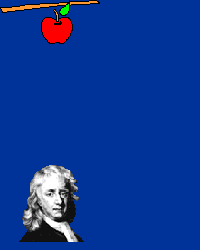


By "standing on the shoulders"
of
Galileo, Kepler
and others, Newton was able to
understand (not
only describe) the laws of planetary motion. His
three laws of motion describe
all types of motion - not
only the motion of the
planets. The movement of the
planets
in their orbits
is governed by the gravitational
force between the
Sun and the Planets. If the Sun
were suddenly to
vanish the planets would escape
from their orbit
and would travel through space
in a straight
line.
Newton's Three Laws of Motion:
1) A body
continues
at rest or in uniform motion in a
straight line
unless acted
upon by some external
force.
2) A body's
change of motion
(velocity) is proportional
to the
force acting
on it and is in the direction of the
force
3) When a body exerts a force on a second body, theF = Force aplied to the object
m= mass of the object
a = resulting acceleration

Newton's
seminal
contribution to planetary motion is
his
Law of Gravitation.
a) The
force is prorportional
to
the PRODUCT of the
masses.
That is, the force with which, say the Sun acts
on a
Planet,
is proportional to the mass M1 of the Planet
and to
the mass M2 of the Sun.
b) The force is inversely proportional to the
SQUARE of
the Sun-Planet
distance r. If the distance between the
Sun and
the Planet is increased by a factor of two, the
force
becomes 4 times smaller (weaker).
c) The force is
always ATTRACTIVE:
the Sun wants to
"engulf"
the Planet - it never pushes it away.
d) G is a
UNIVERSAL constant:
G=6.672x10-11
m3/kg/s2
It is the
same for any
two objects in the Universe!!!